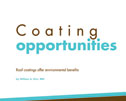Jay, owner of Arrow Roofing Co., had grown up around roofing, so he knew the importance of safety on job sites. Although Jay tried to provide safety training programs for his employees, when work was busy, he and his crews focused on completing jobs and safety issues were not a priority.
One day, an Arrow Roofing crew headed to a job site to install asphalt shingles on a small, residential, steep-slope roof. The day before, Bob, the foreman, had briefly prepped the crew on safety hazards, including falls and how to avoid them.
The roof's slope was 9-in-12 (37 degrees), and the workers installed slide guards as work platforms. The workers also wore personal fall-arrest systems. Ladders were set on firm ground at the proper ratio: 1 foot away from the building for every 4 feet of eave height, extended 3 feet beyond the eave and securely tied off. Each worker also wore proper personal protective equipment, including safety glasses and work gloves.
Several workers were using hammers and saws. Others operated pneumatic nail guns to install the shingles. Each worker had been trained to operate nail guns safely, hanging the hoses over the building's ridge and toward the work area to minimize tripping hazards and prevent the hoses from tangling with other crew members' lifelines.
The crew made good progress throughout the morning. After lunch, one of the younger workers, Joe, grabbed an electrically powered grinder to begin flashing the chimney. He put on his safety glasses and removed the safety guard from the grinder because he didn't want the old flashing material he was cutting from the chimney to collect between the blade and the guard. Joe began cutting the flashing material.
Meanwhile, Bob was busy overseeing sheet metal work taking place on another part of the roof. Suddenly, he heard a piercing cry. He rushed over to find Joe huddled and clutching his right hand.
Bob examined Joe's hand. It was badly cut near the palm and bleeding profusely. Bob raced to the company truck and grabbed the first-aid kit. He used disinfectant to thoroughly clean the wound on Joe's hand and then covered the wound with sterile gauze and bandages. Several workers helped Bob carry Joe off the roof and into Bob's truck.
On the way to the hospital, Bob called Jay and reported what had happened.
Jay met Bob and Joe at the hospital where a doctor examined Joe's hand. The doctor explained the wound would require 15 stitches but Joe would recover full use of his hand. The doctor administered local anesthetic and attended to Joe's injured hand.
After the doctor bandaged Joe's hand, he told Joe he could go home but advised him not to use his hand for at least one week.
The next day, Jay spoke with Bob about the accident. Jay was upset that an electrically powered tool had been operated without a safety guard and that Joe had not known the dangers of operating a grinder without a safety guard. Jay realized luck alone had prevented more accidents from occurring previously.
Jay was determined to improve Arrow Roofing's safety standards. He contacted his local roofing trade association to find out how he could provide more effective employee safety training.
The association's health and safety expert told Jay his employees needed to become more familiar with standard roofing operations and safe practices.
Joe and the others should have known not to use an electrically powered tool without a safety guard, the health and safety expert explained. Whether workers are operating a grinder, hoist or conveyor, any moving parts, such as pulleys, flywheels and belts, always must be guarded.
The expert advised Jay to hire a safety consultant to provide consistent training.
The next day, Jay held a meeting for Arrow Roofing's employees and explained he was going to hire a safety consultant to hold regular safety training sessions. The training would help ensure each Arrow Roofing employee received adequate safety training. From now on, he declared, Arrow Roofing will make sure its employees stay safe.
Peter Greenbaum is NRCA's director of education and training media.



